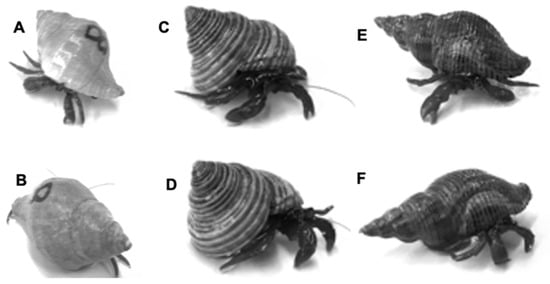Journal Description
Hydrobiology
Hydrobiology
is an international, peer-reviewed, open access journal on freshwater and marine biology, limnology, fisheries, oceanography, and aquatic ecology published quarterly online by MDPI.
- Open Access— free for readers, with article processing charges (APC) paid by authors or their institutions.
- Rapid Publication: manuscripts are peer-reviewed and a first decision is provided to authors approximately 23.3 days after submission; acceptance to publication is undertaken in 4.9 days (median values for papers published in this journal in the second half of 2023).
- Recognition of Reviewers: APC discount vouchers, optional signed peer review, and reviewer names published annually in the journal.
- Hydrobiology is a companion journal of Life and Water.
Latest Articles
Hefting Heavy Shells: Sustenance Demands Caused by Various Abodes of the Hermit Crab Pagurus granosimanus
Hydrobiology 2024, 3(2), 74-84; https://doi.org/10.3390/hydrobiology3020006 - 23 Apr 2024
Abstract
►
Show Figures
Marine hermit crabs inhabiting different species of shells in the rocky intertidal may receive varied benefits and costs. Thick shell walls, sculpture, and certain silhouettes may increase protection against crushing predators and waves, but also the energy cost for bearing such a shell.
[...] Read more.
Marine hermit crabs inhabiting different species of shells in the rocky intertidal may receive varied benefits and costs. Thick shell walls, sculpture, and certain silhouettes may increase protection against crushing predators and waves, but also the energy cost for bearing such a shell. To determine the relative energy demands on Pagurus granosimanus supporting one of three different species of shells commonly inhabited in nature, we measured the consumption of food by free-roaming, size-matched individuals after four days of food deprivation in the laboratory. Surprisingly, while all hermit crabs consumed a significant amount of food, that amount did not differ significantly across the types of shells inhabited, despite the significantly heavier weight of one type of shell (>150% of each of the other two species), and markedly different shell silhouettes. Whether our results were due to the inherent abilities of arthropods to support proportionally immense weights (physiology), reduced movements by animals in heavier shells (plastic behavior), or the way the hermit crabs bear the burden of the shell requires further investigation. Regardless, our results suggest that individuals of P. granosimanus that inhabit heavier shells that likely provide increased protection do not experience corresponding elevated food consumption requirements over the short term, even if those shells are not centered over the body mass of the hermit crab. Pagurus granosimanus crabs can bear the burden.
Full article
Open AccessArticle
Effects of Species of Leaves and Conditioning Time on Vernal Colonization by Temperate Lotic Isopods (Lirceus sp.)
by
Renee E. Heller, Alison N. Stouffer and Erika V. Iyengar
Hydrobiology 2024, 3(2), 63-73; https://doi.org/10.3390/hydrobiology3020005 - 19 Apr 2024
Abstract
While some streams have dense populations of aquatic detritivorous isopods, research on the colonization of leaf packs typically focuses on aquatic insects. To determine whether shifts in dominant local forest species might impact isopod populations, we placed leaf packs of red/sugar maple, American
[...] Read more.
While some streams have dense populations of aquatic detritivorous isopods, research on the colonization of leaf packs typically focuses on aquatic insects. To determine whether shifts in dominant local forest species might impact isopod populations, we placed leaf packs of red/sugar maple, American beech, and red oak on the substratum of riffles and pools in Cedar Creek (Allentown, PA, USA) in April 2019. We retrieved the packs after one week, re-deployed them, and re-collected them after two weeks of submersion, enumerating the number of isopods (Lirceus sp.) upon each retrieval. Surprisingly, neither the species of leaf nor the stream microhabitat significantly affected the number of isopods. However, the duration of leaf conditioning was important; significantly more isopods inhabited leaves after two weeks of submersion than after only one week. Maple and oak leaves displayed significantly more skeletonization after two weeks than the beech leaves, which remained intact. However, the similar numbers of isopods across leaf species suggest either the presence of acceptable, consumable microbial communities on all three species of leaves or that a tradeoff exists between the value of food and the importance of refuge provided by intact leaves.
Full article
(This article belongs to the Special Issue Ecosystem Disturbance in Small Streams)
►▼
Show Figures

Figure 1
Open AccessArticle
Hatchery-Imposed Selection Does Not Impact the Genetic Diversity of Australian Farmed Blue Mussels (Mytilus spp.)
by
Georgina Bramwell, Emi S. Ab Rahim, Aaron G. Schultz, Antoine M. Dujon, Kim Weston, Brett A. Ingram, Sam Jahangard, Frédéric Thomas, Beata Ujvari and Craig D. H. Sherman
Hydrobiology 2024, 3(1), 51-62; https://doi.org/10.3390/hydrobiology3010004 - 02 Mar 2024
Abstract
►▼
Show Figures
Australian blue mussels (Mytilus spp.) are an increasingly important sustainable product of the Australian aquaculture industry. Although important for commercial fisheries, aquaculture may have adverse environmental and ecological impacts. This study assessed the impact of standard hatchery-imposed selection practices on the genetic
[...] Read more.
Australian blue mussels (Mytilus spp.) are an increasingly important sustainable product of the Australian aquaculture industry. Although important for commercial fisheries, aquaculture may have adverse environmental and ecological impacts. This study assessed the impact of standard hatchery-imposed selection practices on the genetic diversity of farmed blue mussels. Using microsatellite markers, relatedness and genetic structure analyses showed that hatchery-reared larvae have high levels of genetic diversity without a significant decline as they move through the hatchery rearing process. Selection and/or genetic drift does appear to be operating during the hatchery rearing process, however, evidenced by an increase in relatedness among larvae over time. Significant shifts in allele frequency as well as genetic clusters provides further evidence that selection is acting on larvae due to the selection practice applied at the hatchery. Comparison of the level of genetic diversity and genetic differentiation of adults from wild and farmed populations provided no evidence that farmed mussels have lower diversity, or that they are genetically swamping local natural populations. The data suggest that careful design and implementation of mussel breeding programs can maintain high genetic diversity among larvae that does not lead to genetic swamping of natural mussel populations in the surrounding area.
Full article

Figure 1
Open AccessArticle
The Devil Firefish Pterois miles (Bennett, 1828): Life History Traits of a Potential Fishing Resource in Rhodes (Eastern Mediterranean)
by
Gerasimos Kondylatos, Alexandros Theocharis, Manolis Mandalakis, Maria Avgoustinaki, Teodora Karagyaurova, Zoi Koulocheri, Sofia Vardali and Dimitris Klaoudatos
Hydrobiology 2024, 3(1), 31-50; https://doi.org/10.3390/hydrobiology3010003 - 28 Feb 2024
Abstract
►▼
Show Figures
The devil firefish Pterois miles (Bennett 1828) is recognized as one of the 100 worst invasive alien species (IAS) in the Mediterranean Sea with significant socioeconomic and ecological implications. A total of 363 individuals were collected between April 2021 and March 2022 from
[...] Read more.
The devil firefish Pterois miles (Bennett 1828) is recognized as one of the 100 worst invasive alien species (IAS) in the Mediterranean Sea with significant socioeconomic and ecological implications. A total of 363 individuals were collected between April 2021 and March 2022 from the Levantine Sea (the Eastern Mediterranean), aiming to assess the current progression of the population. The male to female ratio (1:1.03) did not significantly depart from 1:1, with length–weight relationships exhibiting positive allometric growth. Five age groups were identified, with the third and fourth age groups being the predominant (74% of the population). The highest reproductive intensity was observed during summer followed by autumn. The onset of sexual maturity (L50) for the total population was estimated at 22.44 cm in total length (2.1 years). The asymptotic length was estimated at 45.35 cm for the total population, with males growing larger than females. Longevity was estimated at 14.4 years for the total population. The inflection point was estimated at 4.31 years for the total population. Length with a 50% probability of capture (LC50) was estimated at 23.03 cm, with the respective age (t50) of 2.2 years. The exploitation rate (E = 0.48) indicated that the population is underexploited. The optimum (Fopt) and target (Flim) fishing mortality were higher in comparison with the present fishing mortality (F = 0.41), indicating a potential for commercial exploitation of the species.
Full article
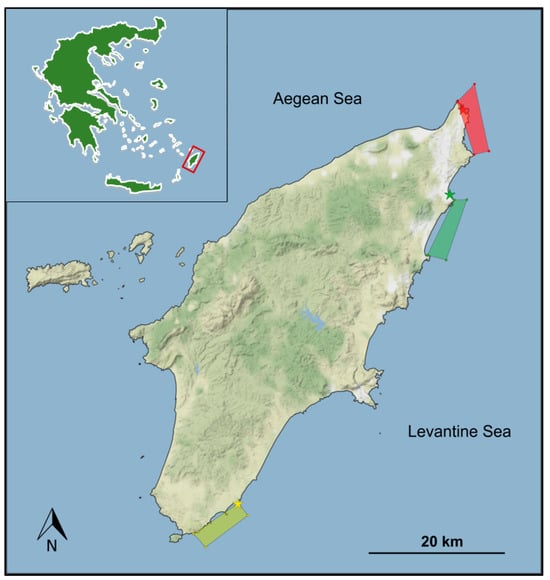
Figure 1
Open AccessReview
Harmful Cyanobacterial Blooms: Going beyond the “Green” to Monitor and Predict HCBs
by
Daniela R. de Figueiredo
Hydrobiology 2024, 3(1), 11-30; https://doi.org/10.3390/hydrobiology3010002 - 02 Jan 2024
Abstract
Under the Climate Change scenario, the occurrence of Harmful Cyanobacterial Blooms (HCBs) is an increasingly concerning problem. Particularly for inland freshwaters, that have human populations depending on them for consumption or recreation, HCBs can lead to serious ecological damages and socio-economic impacts, but
[...] Read more.
Under the Climate Change scenario, the occurrence of Harmful Cyanobacterial Blooms (HCBs) is an increasingly concerning problem. Particularly for inland freshwaters, that have human populations depending on them for consumption or recreation, HCBs can lead to serious ecological damages and socio-economic impacts, but also to health risks for local communities. From satellite imagery to molecular data, there is an increasing number of methodological approaches that can help improve the monitoring and prediction of cyanobacterial blooms. However, although each methodology has its own strengths and limitations, generally there is a lack of data addressing specific and intraspecific information, which has implications for the modelling and prediction of the real dynamics and toxicity of HCBs. The present review intends to make a quick overview on current approaches to monitor cyanobacterial blooms and provide a tier-based integrative perspective for their application. A transversal monitoring at a wide scale should be enhanced but cannot rely only on pigment levels but rather include the specific and intraspecific diversity information that can be obtained from modern molecular tools. This is crucial to achieve the effective prediction, monitoring and management of HCBs under their increasing occurrence and severity trends in freshwaters.
Full article
(This article belongs to the Special Issue Feature Papers in Hydrobiology 2022–2023)
►▼
Show Figures
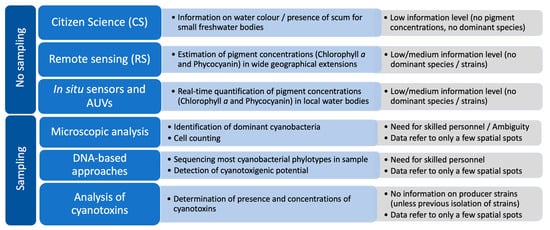
Figure 1
Open AccessArticle
From Fresh to Salt Waters: First Reports of the Red Swamp Crayfish Procambarus clarkii (Girard, 1852) in Mediterranean Marine Waters
by
Alessandro Nota, Alfredo Santovito, Raffaele Gattelli and Francesco Tiralongo
Hydrobiology 2024, 3(1), 1-10; https://doi.org/10.3390/hydrobiology3010001 - 24 Dec 2023
Abstract
The red swamp crayfish Procambarus clarkii (Girard, 1852), native to the southern/southeastern United States and northern Mexico, has been introduced in many countries worldwide. The species has a remarkable invasiveness due to its high reproductive rate and ability to tolerate broad ranges of
[...] Read more.
The red swamp crayfish Procambarus clarkii (Girard, 1852), native to the southern/southeastern United States and northern Mexico, has been introduced in many countries worldwide. The species has a remarkable invasiveness due to its high reproductive rate and ability to tolerate broad ranges of water parameters like salinity. Nevertheless, no consistent observations of P. clarkii have been reported in the marine environment until now. Data demonstrating the presence of the crayfish within marine ecosystems were collected by a personal acquaintance and two volunteers who published photos of the species on Facebook marine biology and fishing groups. The species was identified based on photos taken by these people in the described areas. P. clarkii has been spotted in three different localities, in two of which observations are recurrent. The species can survive miles from the nearest freshwater stream and could potentially colonise marine waters at depths up to 20 m. The multiple observations of P. clarkii collected in our study uncover a persistent presence of the species within some marine areas, rather than its mere sporadic occurrence. Our results highlight the need for further investigation to obtain a comprehensive understanding of the crayfish’s ability to withstand salinity and colonise the marine environment.
Full article
(This article belongs to the Special Issue Feature Papers in Hydrobiology 2022–2023)
►▼
Show Figures
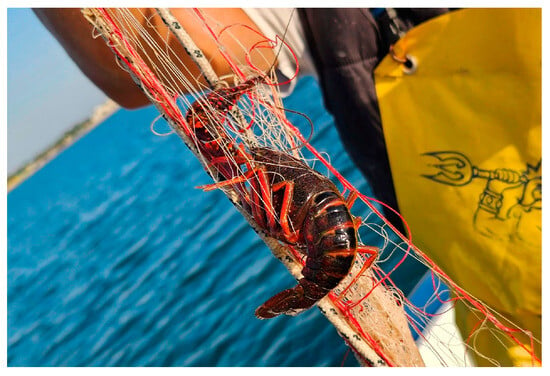
Figure 1
Open AccessArticle
How Tolerant Are Hydroids to Climate-Change-Induced Acute Spikes in Sea Water Temperature? A Case Study of Arctic Dynamena pumila (L., 1758)
by
Nikolay N. Marfenin, Vitaly S. Dementyev and Evgeny V. Nikolaev
Hydrobiology 2023, 2(4), 583-601; https://doi.org/10.3390/hydrobiology2040039 - 13 Nov 2023
Abstract
►▼
Show Figures
The temperature of the water surface layer in the Arctic may increase significantly in the coming decades. To what extent will shallow-water fauna be affected by warming? We investigated this issue using an example of one species of colonial hydroid, Dynamena pumila.
[...] Read more.
The temperature of the water surface layer in the Arctic may increase significantly in the coming decades. To what extent will shallow-water fauna be affected by warming? We investigated this issue using an example of one species of colonial hydroid, Dynamena pumila. We judged its reaction to warming via its pulsation activity and the growth of stolons. Pulsations of the coenosarc in colonial hydroids are a sensitive indicator of the body’s reaction to the influence of environmental factors. We tested the ability of D. pumila colonies to survive and adapt to existing at 25 °C for five days. After raising the temperature from 14 °C to 25 °C, colony growth and the pulsation of stolon growth tips on the first day increased and then decreased during the day. In the following days, the growth pulsations almost ceased, the colonies stopped growing, and their coenosarcs began to exfoliate from their perisarcs. However, by the fourth day, this process slowed down, and the colonies existed in an economy mode of experiencing unfavourable conditions. The thermal shock continued in the experiment for five days. Then, after the temperature dropped from 25 °C to 15–16 °C, all the colonies recovered within five days and continued to grow.
Full article
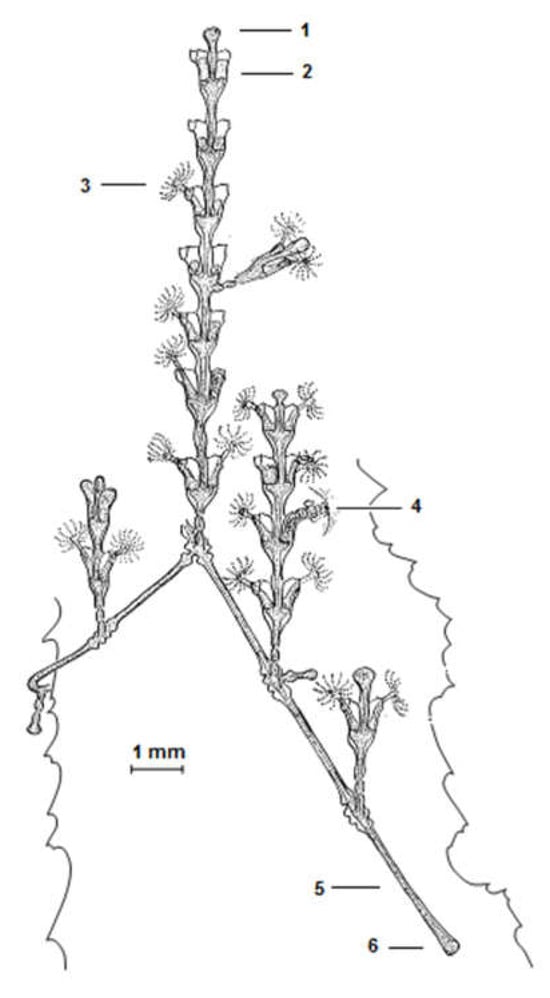
Figure 1
Open AccessCommunication
A Rarely Reported Crustacean Species, Rissoides pallidus (Giesbrecht, 1910) (Stomatopoda, Squillidae), Caught in the Strait of Sicily Waters (Central Mediterranean Sea)
by
Giacomo Sardo, Michele Luca Geraci, Fabio Falsone, Charles Odilichukwu R. Okpala, Danilo Scannella, Antonino Titone and Sergio Vitale
Hydrobiology 2023, 2(4), 575-582; https://doi.org/10.3390/hydrobiology2040038 - 31 Oct 2023
Abstract
►▼
Show Figures
The mantis shrimp Rissoides pallidus (Giesbrecht, 1910) is a rarely reported crustacean species in the central Mediterranean Sea. In December 2020, during a trawl survey off Mazara del Vallo harbor (Strait of Sicily), two specimens of R. pallidus were captured on coastal detritus
[...] Read more.
The mantis shrimp Rissoides pallidus (Giesbrecht, 1910) is a rarely reported crustacean species in the central Mediterranean Sea. In December 2020, during a trawl survey off Mazara del Vallo harbor (Strait of Sicily), two specimens of R. pallidus were captured on coastal detritus and coastal terrigenous mud bottoms at about 132 and 152 m depths. Additional information specific to biometrics, bottom types, depth preference, habitats, and geographic distribution of this crustacean species are provided.
Full article
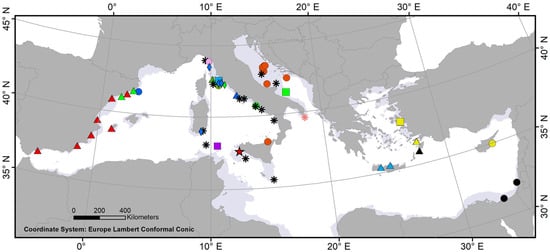
Figure 1
Open AccessArticle
Niphargus carolinensis sp. nov. (Amphipoda: Niphargidae), an Endemic Species in the Northern Distribution Area of the Genus
by
Dieter Weber and Traian Brad
Hydrobiology 2023, 2(4), 554-574; https://doi.org/10.3390/hydrobiology2040037 - 30 Oct 2023
Abstract
►▼
Show Figures
Niphargus carolinensis sp. nov. was sampled from the Carolina Mine located in North Rhine–Westphalia, Germany. The new species is described and compared to phylogenetically related species and species identified in nearby locations. The three phylogenetic markers (i.e., COI, 28S rRNA and ITS2) studied
[...] Read more.
Niphargus carolinensis sp. nov. was sampled from the Carolina Mine located in North Rhine–Westphalia, Germany. The new species is described and compared to phylogenetically related species and species identified in nearby locations. The three phylogenetic markers (i.e., COI, 28S rRNA and ITS2) studied in the examined specimens had different sequences compared to those belonging to species present in locations neighboring the Carolina Mine, i.e., in a radius of 40 km. N. carolinensis sp. nov. is a small-to-medium-sized species that is poorly setose; has a relatively short antenna I, trapezoidal gnathopod propodites, long pereopod VI, and short uropod III; and is not differentiated sexually. The new species described herein is a case of narrow endemism and adds to the diversity of the genus Niphargus in Germany. This work is a contribution to knowledge on groundwater amphipod diversity and the systematics of the genus Niphargus close to the northern border of the distribution of this genus.
Full article
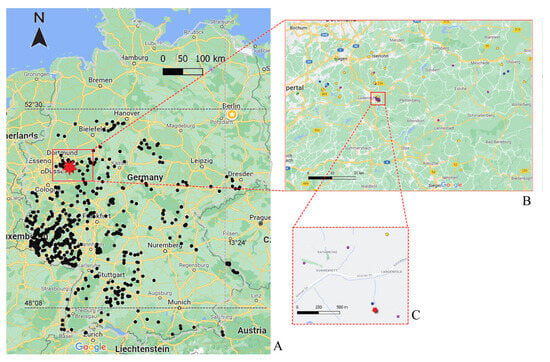
Figure 1
Open AccessArticle
Insights into Diatom Substrate Preferences in the Inter-Tidal Zone of a Subarctic Coast
by
Emilie Arseneault, Reinhard Pienitz, Julie Carrière and Émilie Saulnier-Talbot
Hydrobiology 2023, 2(4), 537-553; https://doi.org/10.3390/hydrobiology2040036 - 30 Oct 2023
Abstract
►▼
Show Figures
Diatoms are reliable environmental bioindicators, but their application in coastal environments remains limited. Substrate has been put forward in the literature as an important variable in determining diatom habitat preferences. This study focuses on benthic diatom assemblages and their relationship with substrate specificity
[...] Read more.
Diatoms are reliable environmental bioindicators, but their application in coastal environments remains limited. Substrate has been put forward in the literature as an important variable in determining diatom habitat preferences. This study focuses on benthic diatom assemblages and their relationship with substrate specificity in a subarctic tidal environment, which could be relevant for environmental monitoring and management. A variety of substrates were sampled and physicochemical variables measured in various areas of the Bay of Sept-Îles region (northern Gulf of Saint-Lawrence, Canada). We recorded 606 species at 14 sites from 11 substrate types to determine the associations between diatoms and their habitats. Our results suggest that the variability of assemblages in the bay is the result of a combination of the identified variables (temperature, salinity, and total dissolved solids), explaining 26.5% of the variation, and other unmeasured variables (e.g., nutrients, wave action, and currents). Substrate was not identified as a significant variable in the statistical analyses. However, some common species in the surveyed assemblages appeared to show preferences for the substrates they colonized.
Full article
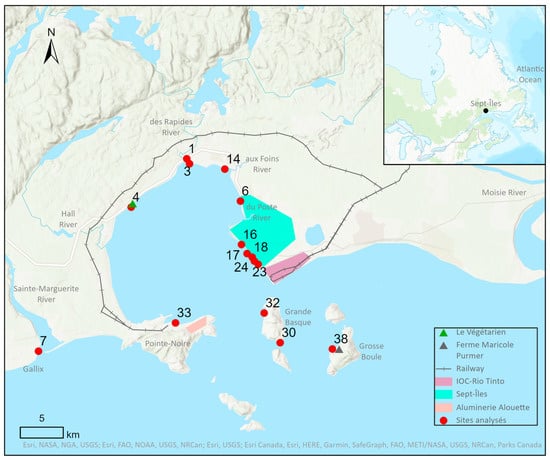
Figure 1
Open AccessArticle
Total Mass Flux in the Northern Humboldt Current System: Rates and Contribution Sources from Central Peru (12° S)
by
Bobby Leigh, Víctor Aramayo, Ursula Mendoza, Federico Velazco, Rainer Kiko, Patricia Ayón, Ernesto Fernández and Michelle Graco
Hydrobiology 2023, 2(4), 521-536; https://doi.org/10.3390/hydrobiology2040035 - 28 Sep 2023
Abstract
►▼
Show Figures
The total mass flux (TMF) of particulate organic matter (POM) is key for understanding the energetic transfer within the “biological pump” (i.e., involving the carbon cycle), reflecting a critical connection between the surface and the bottom. A fixed multi-sediment trap was installed at
[...] Read more.
The total mass flux (TMF) of particulate organic matter (POM) is key for understanding the energetic transfer within the “biological pump” (i.e., involving the carbon cycle), reflecting a critical connection between the surface and the bottom. A fixed multi-sediment trap was installed at 30 m depth in Callao Bay, central Peru from March to December 2020. After recovery, samples were dried and weighed to calculate the TMF and pellet flux. The average TMF was 601.9 mg·m−2·day−1, with 70.2 and 860 mg·m−2·day−1 as the lowest and highest values during “normal conditions”. Zooplankton fecal pellets (ZFP) were found in ovoid (e.g., larvae) and cylindrical (e.g., adult copepods) shapes and their flux contribution to TMF was low, ranging from 0.17 to 85.59 mg·m−2·day−1. In contrast with ZFP, fish fecal pellets (FFP) were found in fragments with a cylindrical shape, and their contribution to the TMF was higher than ZFP, ranging from 1 to 92.56 mg·m−2·day−1. Mean sinking velocities were 4.63 ± 3.47 m·day−1 (ZFP) and 432.27 ± 294.26 m·day−1 (FFP). There is a considerable difference between the ZFP and FFP contributions to TMFs. We discuss the implications of these results regarding a still poorly understood process controlling the POM flux off the Peruvian coast.
Full article
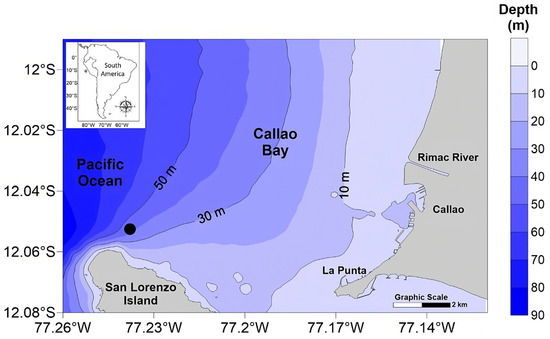
Figure 1
Open AccessTechnical Note
The Potential Use of Remote Underwater Video (RUV) to Evaluate Small-Bodied Fish Assemblages
by
John B. Tweedie, Jaclyn M.H. Cockburn and Paul V. Villard
Hydrobiology 2023, 2(3), 507-520; https://doi.org/10.3390/hydrobiology2030034 - 20 Sep 2023
Abstract
Successful aquatic ecosystem conversation strategies depend on high-quality data from monitoring studies and improved habitat requirement knowledge. Remote Underwater Video (RUV) is a non-extractive alternative to capture-based techniques for studying and monitoring fish and is increasingly used in smaller channels. This study uses
[...] Read more.
Successful aquatic ecosystem conversation strategies depend on high-quality data from monitoring studies and improved habitat requirement knowledge. Remote Underwater Video (RUV) is a non-extractive alternative to capture-based techniques for studying and monitoring fish and is increasingly used in smaller channels. This study uses field observations made with waterproof Sony HDR-AS100V action cameras positioned in stream channels to determine species and population during various flow conditions across three sites within the Credit River Watershed, Ontario, Canada. Six fish species were identified, and individual fish lengths were estimated using the inverse square law to proportionally adjust size scales to fish positions relative to the camera. Successful identification and measurements were limited by turbidity, with camera placements in >6 NTU conditions (18% of all placements) resulting in at least one fish observed in the frame. With over 24 h of video recordings with 94 individual video clips, the optimal filming duration was determined to be 20–25 min. RUV surveys provide managers with useful monitoring data regarding fish present in an environment in a cost-effective and efficient manner. Additionally, as the method is largely non-invasive, RUV surveys are especially useful for studying fish behaviour, sensitive or endangered species, and working in difficult-to-access channels (e.g., shallow, faster flow).
Full article
(This article belongs to the Special Issue Fish Welfare in Fisheries and Aquaculture)
►▼
Show Figures
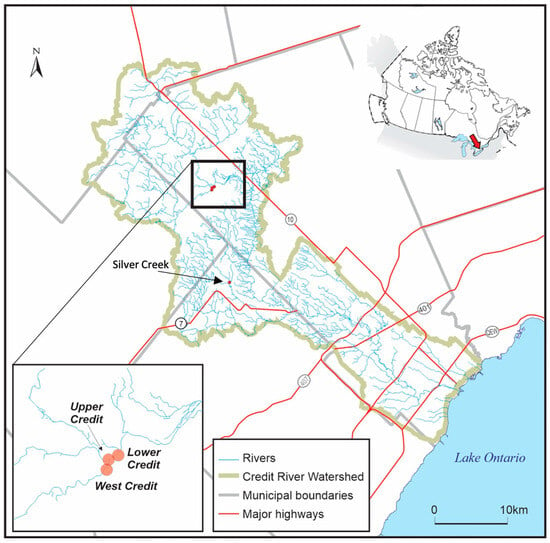
Figure 1
Open AccessArticle
Inhibitory Effect of Aqueous Extracts from Egeria densa Planch. on Cyanobacteria Microcystis aeruginosa (Kützing) Lemmermann Growth
by
Ashika Wijesinghe, Mudalige Don Hiranya Jayasanka Senavirathna and Takeshi Fujino
Hydrobiology 2023, 2(3), 491-506; https://doi.org/10.3390/hydrobiology2030033 - 15 Sep 2023
Cited by 1
Abstract
►▼
Show Figures
This study aimed to investigate the allelopathic effect of live Egeria densa Planch. and its aqueous extracts in inhibiting the cyanobacterium Microcystis aeruginosa (Kützing) Lemmermann through a possible growth inhibition pathway. Under coexistence, the presence of live E. densa reduced the growth of
[...] Read more.
This study aimed to investigate the allelopathic effect of live Egeria densa Planch. and its aqueous extracts in inhibiting the cyanobacterium Microcystis aeruginosa (Kützing) Lemmermann through a possible growth inhibition pathway. Under coexistence, the presence of live E. densa reduced the growth of M. aeruginosa by 48% compared to when M. aeruginosa was alone. Consequently, we prepared two separate aqueous extracts with distilled water: one from E. densa plants collected from monocultures, and the other from E. densa plants collected from co-cultivation with M. aeruginosa. At a concentration of 0.5 g/L, both extracts successfully suppressed the growth of M. aeruginosa throughout the 5-day exposure period. The extracts obtained from E. densa plants grown in a combined culture with M. aeruginosa showed significant growth-inhibiting capabilities compared to the extracts obtained from E. densa monoculture (p < 0.05). They showed 22% more growth inhibition compared to cultures exposed to monoculture extracts at day 5, indicating that the production of allelochemicals in E. densa was induced during co-existence with cyanobacteria. However, the higher concentrations (2 and 4 g/L) of both extracts did not effectively exhibit a successful inhibitive ability, possibly due to the presence of high nutrient concentrations, specifically PO43−, which may be potentially suppressing the activity of allelochemicals. Further studies are recommended in identifying the specific allelochemicals and exploring their practical implementation in the field.
Full article
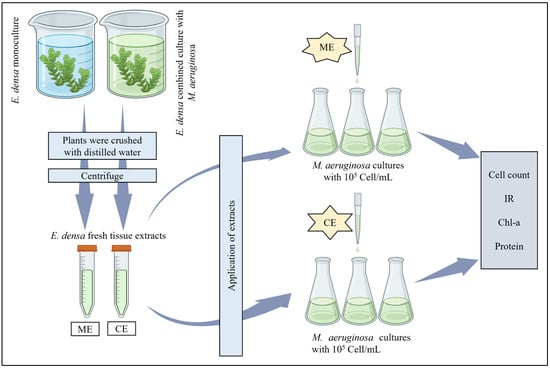
Figure 1
Open AccessArticle
Mechanical Removal of Minnows (Gila bicolor) to Improve Water Quality in a Hydropower Impoundment, Lemolo Lake, Oregon, USA
by
Joseph Eilers, Kellie Vache and Richard Grost
Hydrobiology 2023, 2(3), 475-490; https://doi.org/10.3390/hydrobiology2030032 - 17 Aug 2023
Abstract
A project to mechanically remove an over-abundant population of cyprinids (Gila bicolor) was tested in a hydropower impoundment, Lemolo Lake (USA). The netting program removed 29.7 tons of fish (163 kg/ha) over a seven-year period that resulted in a reduction in
[...] Read more.
A project to mechanically remove an over-abundant population of cyprinids (Gila bicolor) was tested in a hydropower impoundment, Lemolo Lake (USA). The netting program removed 29.7 tons of fish (163 kg/ha) over a seven-year period that resulted in a reduction in the intensity and duration of cyanobacteria blooms. However, the suppression of the tui chub population apparently allowed for a residual population of kokanee (Oncorhynchus nerka) to proliferate. The resurgence of the kokanee, combined with the initiation of a rainbow trout stocking program, offset some of the gains in water quality achieved with the reduction of tui chub biomass. The dominant cyanobacterium present in Lemolo Lake transitioned to Gloeotrichia echinulata in 2013, but the majority of these colonies were apparently derived from an upstream lake. The changes in water quality from 2005–2013 were simulated for Lemolo Lake using the two-dimensional, hydrodynamic model, CE-QUAL-W2. The model reproduced many aspects of the water quality in Lemolo Lake and was used, in combination with a simple Bayesian model, to evaluate a number of potential scenarios for further improving water quality in the impoundment. Promoting a deeper drawdown of the hydroelectric impoundment during the winter to selectively increase entrainment of tui chub and kokanee, combined with continued netting targeted at tui chub, was judged to offer the greatest opportunity to manage the facility for water quality, fisheries and hydropower objectives.
Full article
(This article belongs to the Special Issue Fish Welfare in Fisheries and Aquaculture)
►▼
Show Figures
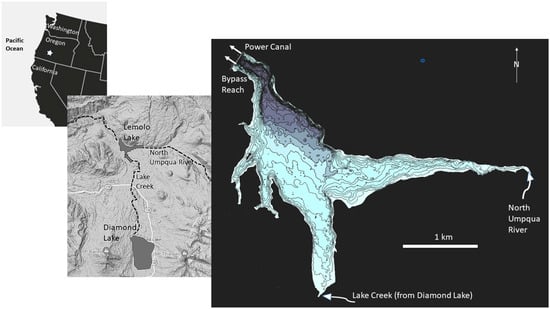
Figure 1
Open AccessBrief Report
Effects of Predation Tags on Growth and Stress Response in Juvenile Rainbow Trout Oncorhynchus mykiss
by
Emma K. Millsap, Nathan Huysman, Dylan A. Gravenhof, Mark J. Fincel and Michael E. Barnes
Hydrobiology 2023, 2(3), 467-474; https://doi.org/10.3390/hydrobiology2030031 - 20 Jul 2023
Abstract
Acid-sensitive predation tags have recently been introduced to fisheries management. The objective of this study was to ascertain the impact of these tags on juvenile rainbow trout Oncorhynchus mykiss physiology and growth after implantation. Twenty approximately 13 g rainbow trout were placed into
[...] Read more.
Acid-sensitive predation tags have recently been introduced to fisheries management. The objective of this study was to ascertain the impact of these tags on juvenile rainbow trout Oncorhynchus mykiss physiology and growth after implantation. Twenty approximately 13 g rainbow trout were placed into each of five tanks, with ten surgically implanted with dummy acid-sensitive predation tags and ten control fish not subjected to surgical procedures. Glucose, hematocrit, tag-retention, survival, and growth metrics were collected for 30 days post-surgery. Four tagged fish died while no control fish died. Tag retention was 76%, with tags lost in weeks 2, 3, and 4. Control fish were significantly longer and gained significantly more weight at the end of the experiment. Hematocrit levels for the tagged fish dropped significantly over the course of the trial and were 30% lower than those of the untagged control fish at the end of 30 days. Glucose levels were highly variable for both treatments. The results of this study indicate the negative impacts of predation tagging on the physiology of juvenile rainbow trout. Results from predation field trials should be interpreted with caution because the tagged fish are likely at a competitive disadvantage compared to their untagged conspecifics.
Full article
(This article belongs to the Special Issue Fish Welfare in Fisheries and Aquaculture)
►▼
Show Figures
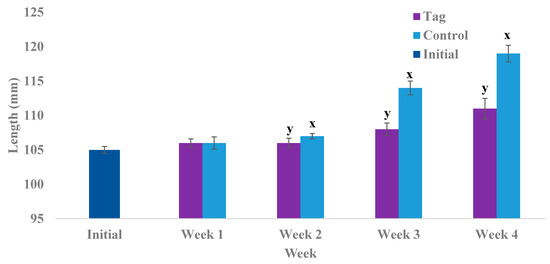
Figure 1
Open AccessEditorial
Ecology of Aquatic Invertebrates in Springs and Headwater Streams: Imperiled Habitats in a Changing World
by
David E. Bowles and Weston H. Nowlin
Hydrobiology 2023, 2(3), 463-466; https://doi.org/10.3390/hydrobiology2030030 - 17 Jul 2023
Abstract
Headwater streams and springs and their resident biotas are vulnerable to a broad range of anthropogenic stressors [...]
Full article
(This article belongs to the Special Issue Ecology of Aquatic Invertebrates in Springs and Headwater Streams: Imperiled Habitats in a Changing World)
Open AccessArticle
Short-Term Responses of Aquatic Ecosystem and Macroinvertebrate Assemblages to Rehabilitation Actions in Martil River (North-Western Morocco)
by
Achraf Guellaf, Jalal Kassout, Vladimiro Andrea Boselli, Nard Bennas, Majida El Alami, Sanae Errochdi and Kawtar Kettani
Hydrobiology 2023, 2(3), 446-462; https://doi.org/10.3390/hydrobiology2030029 - 03 Jul 2023
Cited by 1
Abstract
►▼
Show Figures
This study aimed to evaluate the effects of the Martil River rehabilitation project and recently constructed dam infrastructures to reduce flood risks and to promote local socio-economic development on the ecological integrity of the river. The assessment focused on changes in fluvial landforms
[...] Read more.
This study aimed to evaluate the effects of the Martil River rehabilitation project and recently constructed dam infrastructures to reduce flood risks and to promote local socio-economic development on the ecological integrity of the river. The assessment focused on changes in fluvial landforms over time and the evaluation of aquatic ecosystems based on six physicochemical parameters (temperature, pH, electrical conductivity, dissolved oxygen, biochemical oxygen demand, and chemical oxygen demand), morpho-hydrological variables (stream width, water depth, and current speed), habitat indices (QBR, IHF, and MQI), and macroinvertebrate assemblages of EPT, OCH, and Chironomidae (Diptera) at five stations from autumn 2015 to spring 2018 (prior to and during the rehabilitation actions). The results showed that the river rehabilitation project led to profound changes in Martil River’s ecosystem and water quality over time. Physicochemical and habitat measurements at the rehabilitated sites revealed a major change in macroinvertebrate communities due to changes in fluvial landforms in relation to flow-sediment regimes. As a result, some typical species of lentic habitats disappeared, while alien, opportunistic, and lotic species appeared.
Full article
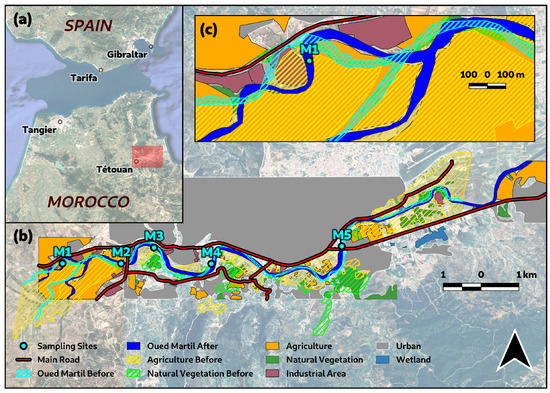
Figure 1
Open AccessArticle
DNA Barcoding and Phylogenetics Relationship of Pangasiid Catfishes in Peninsular Malaysia Revealed the Impacts of Aquaculture on the Native Species Conservation
by
Baharuddin Haslawati, Md Ali Amatul-Samahah, Mohammed Rizman-Idid and Sekaran Muniandy
Hydrobiology 2023, 2(2), 431-445; https://doi.org/10.3390/hydrobiology2020028 - 20 Jun 2023
Abstract
Pangasiids are an economically significant group of catfish, and many pangasiids are threatened in the wild from anthropogenic pressures, including increases in fishing pressure, habitat degradation, and improperly managed aquaculture practices. This study demonstrates the usage of DNA barcoding of the Cytochrome Oxidase
[...] Read more.
Pangasiids are an economically significant group of catfish, and many pangasiids are threatened in the wild from anthropogenic pressures, including increases in fishing pressure, habitat degradation, and improperly managed aquaculture practices. This study demonstrates the usage of DNA barcoding of the Cytochrome Oxidase subunit I (COI) gene as an identification tool in detecting potentially threatening invasive pangasiid species by establishing the diversity and phylogenetic relationship of Pangasiidae catfishes in Peninsular Malaysia. A neighbour-joining (NJ) dendrogram (Kimura-2-parameter model) generated five clades to represent distinct genera. Pangasius was further subdivided into two clades (Clade A: Pangasius bocourti-P. djambal and Clade B: P. nasutus-P. conchophilus). Given the marginal genetic divergence, indigenous and non-native species should be treated cautiously in allopatrically distributed species. The analysis used Automatic Barcode Gap Discovery (ABGD) and revealed barcode gaps between the intraspecific and interspecific distances. The sequences were partitioned into five groupings, corresponding with the species delineation based on the distribution of pairwise differences, which could not be differentiated using the NJ dendrogram. ABGD allows the recognition of one or two additional species using the recursive approach, but other taxonomic methods should be considered for a solid conclusion. DNA barcoding demonstrates the identification of closely related species, thus justifying its application towards the conservation of these fish.
Full article
(This article belongs to the Special Issue Fish Welfare in Fisheries and Aquaculture)
►▼
Show Figures
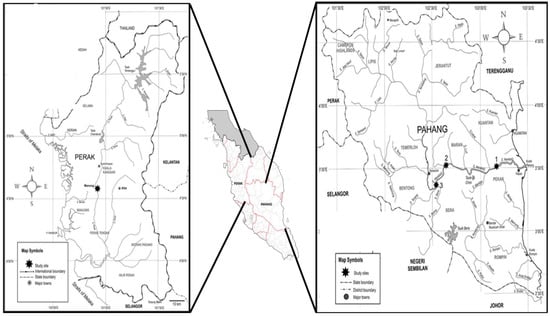
Figure 1
Open AccessArticle
Recurringly Hypoxic: Bottom Water Oxygen Depletion Is Linked to Temperature and Precipitation in a Great Lakes Estuary
by
Nathan M. Dugener, Anthony D. Weinke, Ian P. Stone and Bopaiah A. Biddanda
Hydrobiology 2023, 2(2), 410-430; https://doi.org/10.3390/hydrobiology2020027 - 17 Jun 2023
Cited by 3
Abstract
Hypolimnetic hypoxia is expanding globally due to anthropogenic eutrophication and climate warming. Muskegon Lake, a Great Lakes estuary, experiences annually recurring hypoxia, impairing ecological, social, and economic benefits. Using high-frequency, time-series Muskegon Lake Observatory (MLO) data, we quantified the dynamics of hypoxia and
[...] Read more.
Hypolimnetic hypoxia is expanding globally due to anthropogenic eutrophication and climate warming. Muskegon Lake, a Great Lakes estuary, experiences annually recurring hypoxia, impairing ecological, social, and economic benefits. Using high-frequency, time-series Muskegon Lake Observatory (MLO) data, we quantified the dynamics of hypoxia and developed a hypoxia severity index to estimate the spatiotemporal extent of hypoxia during 2011–2021. We also analyzed United States Geological Survey’s temperature and discharge data on the Muskegon River to explain the annual variability in the hypoxia severity index. Severe hypoxia occurred in warmer years with greater stratification, fewer wind mixing events, warmer winter river temperatures, and less winter and spring precipitation, as in 2012 and 2021. Conversely, milder hypoxia was prevalent in colder years with a later stratification onset, more mixing events, colder river temperatures, and more winter and spring precipitation, as in 2015 and 2019. Thus, knowledge of environmental conditions prior to the onset of stratification may be useful for predicting the potential severity of hypoxia for any year. While consistent multi-year trends in hypoxia were not discernible, our findings suggest that temperature and precipitation are major drivers of hypoxia and that as surface waters warm, it will lead to the further deoxygenation of Earth’s inland waters.
Full article
(This article belongs to the Special Issue Feature Papers in Hydrobiology 2022–2023)
►▼
Show Figures
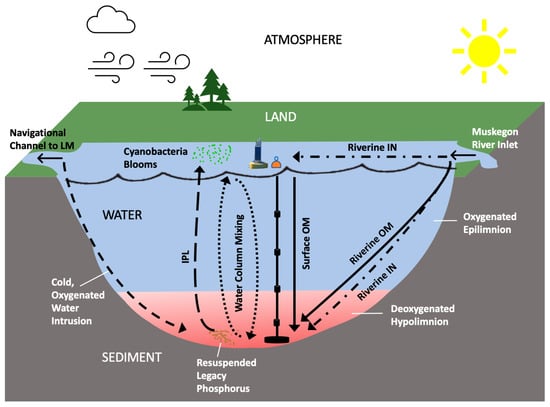
Figure 1
Open AccessReview
Pharmaceuticals in Water: Risks to Aquatic Life and Remediation Strategies
by
Aqib Hassan Ali Khan and Rocío Barros
Hydrobiology 2023, 2(2), 395-409; https://doi.org/10.3390/hydrobiology2020026 - 14 Jun 2023
Cited by 7
Abstract
The presence of pharmaceuticals in the aquatic environment presents a challenge to modern science. The most significant impact this can induce is the emergence of antibiotic resistance, which can lead to a global health emergency. It is important to note that the impact
[...] Read more.
The presence of pharmaceuticals in the aquatic environment presents a challenge to modern science. The most significant impact this can induce is the emergence of antibiotic resistance, which can lead to a global health emergency. It is important to note that the impact of pharmaceuticals in the aquatic environment is not limited to antibiotic resistance. Pharmaceuticals can also affect the behaviour and reproductive systems of aquatic organisms, with cascading effects on entire ecosystems. Numerous studies have reported the emergence of pharmaceuticals due to the uncontrolled disposal of polluted domestic, agricultural, and industrial wastewater in water bodies. This work discusses the potential of pharmaceuticals that on one hand are highly important for mankind, yet their non-judicious usage and disposal induce equally intriguing and problematic conditions to the health of aquatic systems. Pathways through which pharmaceutics can make their way into water bodies are discussed. Furthermore, the risk imposed by pharmaceuticals on aquatic life is also elaborated. The possible and pragmatic remediation methods through which pharmaceutical products can be treated are also discussed. Emphasis is placed on the potential of phytoremediation and advanced oxidative process, and the factors affecting the efficacy of these remediation methods are discussed.
Full article
(This article belongs to the Special Issue Feature Papers in Hydrobiology 2022–2023)
►▼
Show Figures
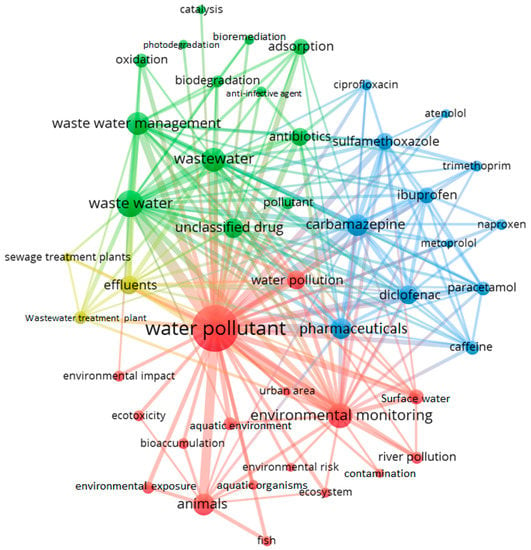
Figure 1
Highly Accessed Articles
Latest Books
E-Mail Alert
News
Topics

Conferences
Special Issues
Special Issue in
Hydrobiology
Ecosystem Disturbance in Small Streams
Guest Editor: Baik-Ho KimDeadline: 30 June 2024
Special Issue in
Hydrobiology
Long-Term Dynamics of Biodiversity in Aquatic Environments
Guest Editor: Emilie Saulnier-TalbotDeadline: 31 December 2024

